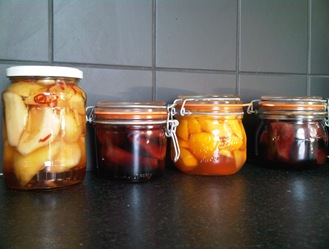It’s August and the air is full. Of dancing spores and dandelion clocks, of lavender scents brushed from the flowers by bees too busy to stay with their fleeting wanton caresses. The sweet tang of muck spread on nearby fields occasionally reigns. Big Norfolk skies swirl overhead, punctuated by weather-fronts and their breezy boundaries, gigantic sheep-like clouds an endless parade of shapes; summer is busying about with a threat of packing up and shipping out. Like the dog helplessly watching its beloved owner pack for a holiday, I am hoping that there’s been some mistake. Surely it’s not leaving so soon, whatever the Met Office says.
Severe weather warnings aside, there are signs of autumn’s impending bounty: bright ornaments sprinkled amongst the foliage in trees and hedges, the flowers fading, making way for the berries. We are just a couple of weeks away from frenzied pilfering sessions – of plums, apples, blackberries and early sloes. But right now, patience must be deployed. Until the hedgerow harvest, why not take inspiration from the bees? The lavender’s in abundance – it seems a shame not to use it. It’s great studded into lamb, rosemary-style.
I attempted lavender cake once (bastardized from some sponge recipe or other) and it was amazing, even if I do say so myself. It was one of those rare times when improvisation paid off. God knows how. However, I am not a fool – I know this happens only once if you’re lucky, so I nicked a failsafe formula off someone who probably knows a lot better. Inconveniently, it’s written in American, which if you don’t understand you can decipher courtesy of Delia’s conversion table; as everyone knows, you can’t go wrong with Delia.
To decorate, you can really go all Laura Ashley on it. I promise you it won’t taste like pot pourri. if you still don’t believe me, you can just infuse a pot of sugar with a stalk for a few days beforehand, discard it and use the sugar, rather than grinding the flowers themselves.
Serves 6–8
2 stalks lavender flowers (or 2 tbsp lavender flowers)
½ cup caster sugar
250g unsalted butter, at room temperature
¼ cup honey
3 eggs
1½ cups self-raising flour
¾ cup buttermilk
2 tbsp sifted icing sugar, to serve
lavender flowers (extra), to decorate
thick cream, to serve
1 Preheat oven to 180C. Grease and line a 22cm spring-form cake tin with greaseproof paper. Grind lavender flowers and sugar together with a mortar and pestle until finely ground.
2 Using an electric beater, beat lavender sugar, butter and honey until light and creamy. Add eggs, 1 at a time, beating well after each addition. Sift flour into mixture. Using a large metal spoon, gently fold flour and buttermilk into mixture. Spoon into prepared baking pan. Smooth top. Bake for 1 hour or until cooked when tested with a skewer.
3 Stand for 5 minutes before releasing clamp and inverting cake onto a wire rack. Dust with icing sugar and sprinkle with flowers (extra) if you wish. Serve with thick cream.
Note: it’s important to use lavender that is home-grown and pest free, not commercially grown lavender that may have been sprayed with chemicals.
I am challenging the best baker I know, Jemima, to make this (she also happens to be my sister-in-law but these facts are unrelated). Just because. Because of those ethereal Honey Buns (courtesy of Valentine Warner) she treated the BSG and me to the other week, drenched in an orange-y nectar. That was indeed a feast that warrants its own post…







